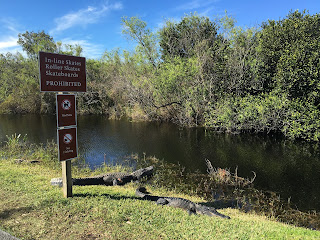The winter is flying by! Normally, winter in the Everglades is the dry season -- meaning little to no rain and mild temperatures. This winter however, has been exceptionally wet. January 2016 had the most rainfall since record-keeping began in 1932. As a result, the Everglades is still much wetter than normal for this time of year. Because of the high water levels, fish are more spread out than normal, and their predators are too.
According to my coworkers who've worked here for many years, the visible wildlife is a fraction of normal. Luckily for me, I have no basis of comparison, and continue to be amazed by the wildlife. Alligators especially, so I thought it was time to share some more photos.
This guy seemed to be napping and basking in the sun right on the trail. He laid there for hours. The fourth grade students I had on my field trip that day went home with a great story to tell!
I saw these two basking on the grass right near the parking lot at Shark Valley, in the northern part of the national park. They couldn't be bothered by the hundreds of visitors walking past.
I'm learning that it's not too difficult to convince northerners to visit South Florida in the winter :) I was fortunate to have my best friends from Dartmouth visit a couple weekends ago. We had a great time exploring the Everglades, and relaxing on the beach in Key Largo.
We also took a glass-bottom boat tour in John Pennekamp state park. Looking down on the brilliantly-colored fish and coral was amazing. I look forward to going out there again with a snorkel!











